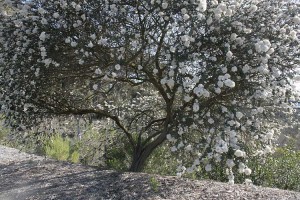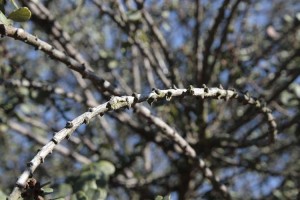Ceanothus season is here in force. One of the local stars is a species with the unfortunate common name of “warty-stem ceanothus.” Neither is its Latin name of Ceanothus verrucosus especially glamorous. But hopefully you can see how cool a plant it is in these photos.
If my weekday desk had a window I’d look out on a the head of a little canyon that’s a mixture of introduced eucalyptus and a partially restored snippet of coastal sage scrub habitat. A couple hundred yards away in the re-wilded area are several of these ceanothus that have been glowing white for the last month with their clouds of flowers.
Last November these ceanothus were stemmy but gracefully-branched shrubs. Adapted to survival for many months without water its leaves are tiny and sparse. Still you could easily walk past them.
If you stopped to look at the plant, you’d easily see these interesting “warts” that give the plant its name. The warts are actually leaf-bases (stipules) that remain on the branches long after the leaves are gone.
By January the formerly sparse looking plants were responding to the rains with swelling flower buds.
And a month later the plants were going at it big time…
California could be the evolutionary epicenter of the genus ceanothus. Of the approximately 52 ceanothus species in the US, 46 are found here. Of those 46 about 38 occur only here.
That’s a lot of competition for precious space and water in a nursery, but several native California specialists in southern California offer this plant. You can see that this could be a choice addition to a dry garden where you want an airy, graceful shrub that’s 7-8 feet tall and about 10 feet across. As I struggle with ceanothus from outside my immediate area, I keep thinking I should use more selections that are better suited to what I have to offer them.
I love this plant, warts and all. But people in the end seem to buy the name and the image as much as they buy the plant. Just rebrand the plant with a friendlier (but more trite) horticultural name like “Cloud Blossom Lilac” and just stand back as everyone snaps it up.







Ah, memories…I used to command one of those rare fortress portholes with a view when I worked at the library (and you were pretty close too) but I never got out to examine the individual plants close up. Last time I visited, though, the restoration on the north side looked to be coming along nicely. The rabbits sure were plentiful! Thanks for the closer look.
Beautiful! And I bet it’s humming with bees this time of year. Yes, that would be a nice addition to the garden…
like changing grey-green to “seafoam” in the J. Crew catalogs, it’s all in the spin. Looks like a great plant, and the flower reminds me of Buddleia.
Perhaps we could start a campaign similar to the pork one? Ceanothus, the other drought tolerant shrub.
It’s a beauty. Looks like it would be a very bee friendly plant as well making it even more attractive.
It’s so interesting to see the differences between C. verrucosus (reminds me of Charlie and the Chocolate Factory: Veruca Salt I believe was the charming name of one of the children touring the factory) and some of my own local ceanothus.
Those 52 or so species really are approximate, I’m impressed at any firmly-identified ceanothus. Some of the ones here are clearly a certain species, but many are ambiguous. I was trying to i.d. one of them with the aid of a chart in a wildflower book. Someone who was more experienced than I peered over just when I was reading the part about how they hybridize like crazy in the wild and said, “There are a lot more kinds than they could ever put in that chart. And people keep arguing over whether they are a subspecies or just a variant.”
Count me in as a Ceanothus fan as well. I planted many in Portland, Oregon and Reno, Nevada and, for the most part, they did well. My varieties tended to the blue, simply because it is such a rare garden color. Sue me – I like color. They are getting more cachet, actually, elsewhere, as their hardiness becomes increasingly obvious. Believe it or not, it is a rather new plant to many in those climes.